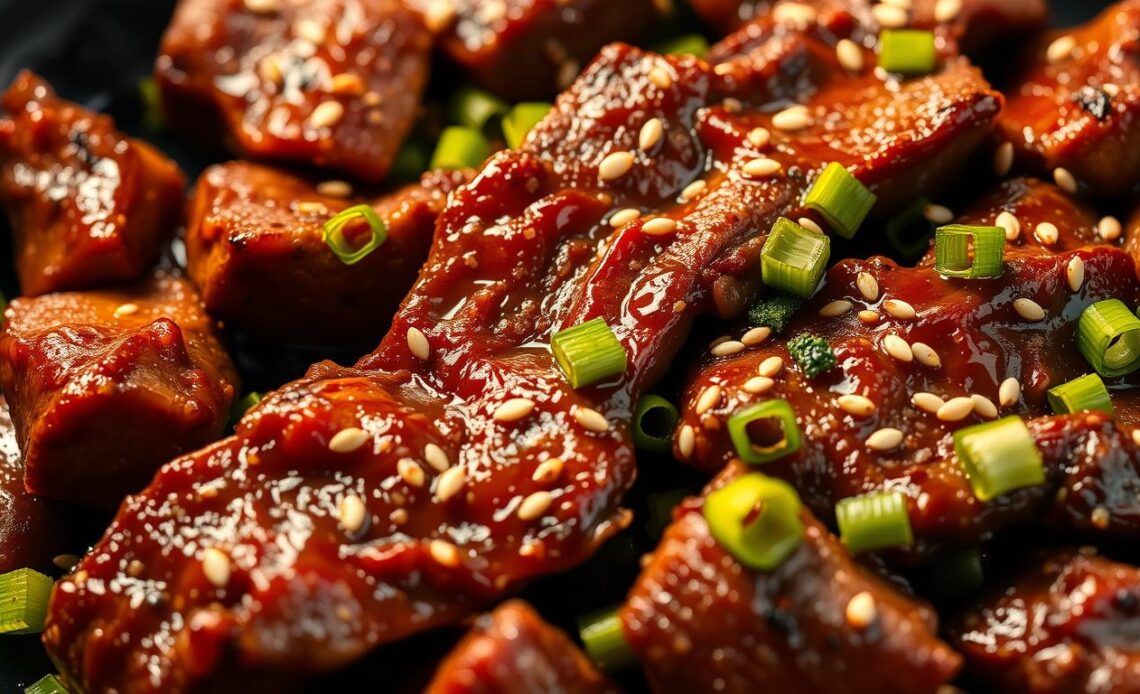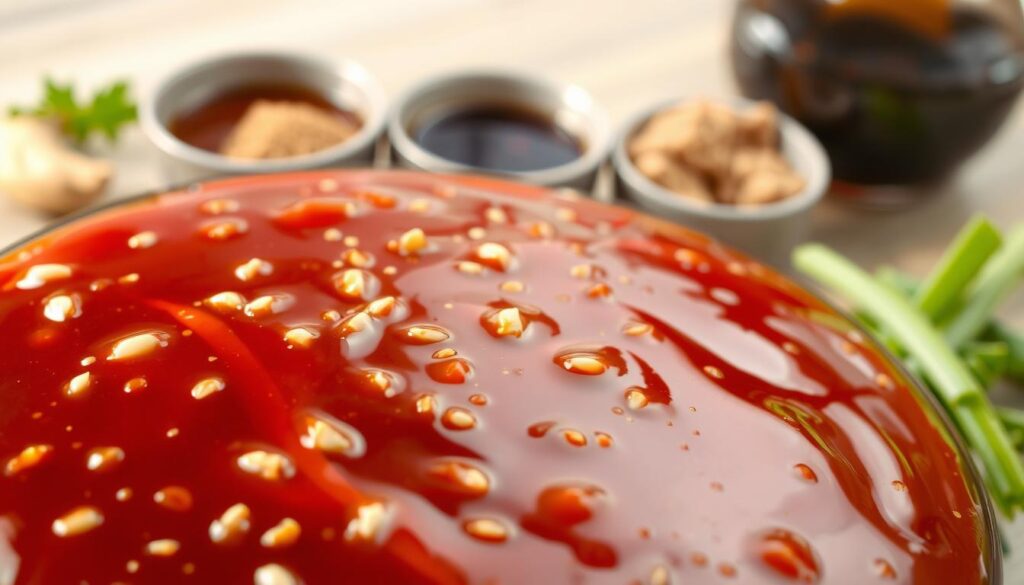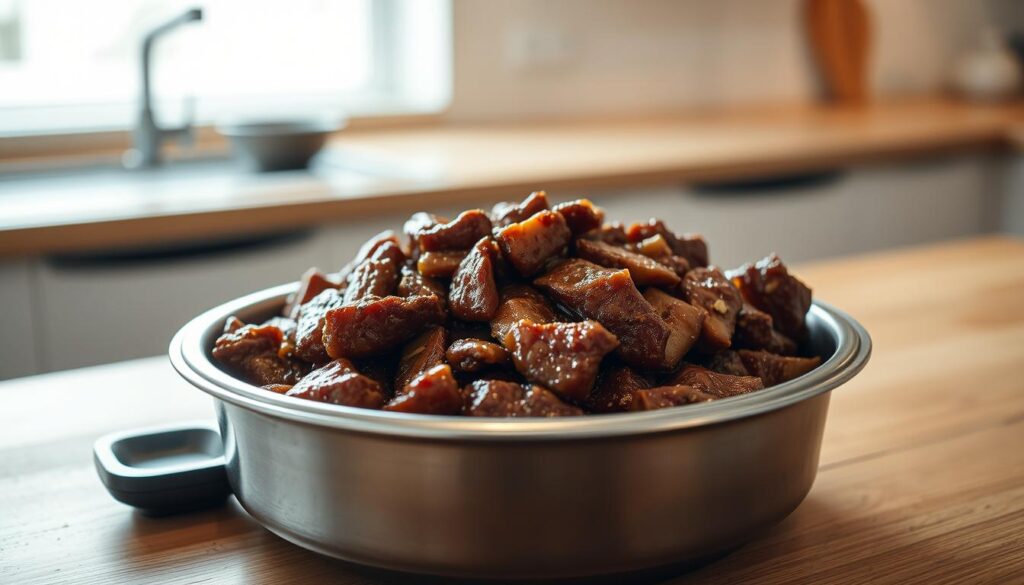
Imagine enjoying a dish that’s both sweet and savory. The meat is tender and melts in your mouth. You’re about to try the joy of Korean cuisine with a traditional dish that’s easy and fun to make.
Beef Bulgogi is a favorite Korean dish. It’s made with thinly sliced beef marinated in a sweet and savory sauce. It’s great for busy nights and can be served with rice, noodles, or in lettuce wraps. You can make this authentic Korean dish at home with a simple beef bulgogi recipe.
Key Takeaways
- Learn how to make an authentic bulgogi marinade for tender and flavorful beef.
- Discover the versatility of Korean Beef Bulgogi and how it can be served.
- Enjoy a delicious and easy-to-make dish that’s perfect for any night.
The Rich History of Beef Bulgogi in Korean Cuisine
Bulgogi, meaning ‘fire meat,’ has been a favorite in Korea for many years. It started as a simple way to cook thin meat slices over an open flame. Now, it’s a marinated beef dish loved by many.
Origins of Bulgogi in Ancient Korea
The story of bulgogi goes back to the Goguryeo era. It was first mentioned in the ‘Dongguk Yijo Soryak,’ an old Korean medical text. Back then, it was just cooking thin beef slices over an open fire.
This method was not just for food. It was also a way for people to come together.
Evolution into Modern Bulgogi
As time went on, bulgogi changed. It started using soy sauce, garlic, and other seasonings. These additions made it the tasty, slightly sweet dish we know today.
The changes in bulgogi show how Korean cuisine adapts. It keeps its traditional roots while trying new things.
This dish has become a big part of Korean food culture. Its rich history and cultural importance make it more than food. It’s a way to connect with one’s heritage.
What Makes an Authentic Beef Bulgogi Special
Authentic beef bulgogi is all about a special marinade. It mixes soy sauce, garlic, ginger, and more. This blend gives bulgogi its unique sweet and savory taste.
Key Characteristics of Traditional Bulgogi
Traditional beef bulgogi is known for its tender beef. It’s sliced thinly to soak up the marinade’s flavors well. The marinade is a mix of:
- Soy sauce
- Garlic
- Ginger
- Sugar
- Sesame oil
- Black pepper
Together, these ingredients create a taste that’s both sweet and savory. The quality of the ingredients and the marinade’s balance are key to the dish’s authenticity.
Regional Variations Across Korea
Korea’s culinary scene is rich and diverse, and bulgogi is no different. Each region adds its own twist to the traditional recipe, using local tastes and ingredients.
Some notable regional variations include:
- Jeju Island Bulgogi: This version uses black pork from Jeju Island, giving it a unique flavor.
- Gyeongsang Bulgogi: Sweeter than others, it has a different soy sauce to sugar ratio.
- Jeolla Bulgogi: It has a spicy kick, thanks to more red pepper flakes in the marinade.
These variations show how bulgogi can be adapted to different tastes while keeping its core essence.
Essential Ingredients for Perfect Beef Bulgogi
The secret to a tasty beef bulgogi is in its key ingredients. To make a simple bulgogi recipe, knowing the right parts is essential.
The beef is the base of bulgogi. Choosing the right cut is key for tender and flavorful meat.
Selecting the Right Cut of Beef
For a true beef bulgogi recipe, use thinly sliced ribeye or sirloin. These cuts are tender and full of flavor.
- Ribeye: Known for its marbling, which adds flavor and tenderness.
- Sirloin: A leaner cut that still offers great flavor when cooked correctly.
Traditional Korean Seasonings
Traditional Korean seasonings make bulgogi unique. Key ingredients include:
| Ingredient | Purpose |
|---|---|
| Soy Sauce | Provides a salty, umami flavor. |
| Garlic | Adds a pungency and depth. |
| Ginger | Contributes a warm, spicy note. |
Fresh Produce Components
Fresh produce boosts bulgogi’s flavor and texture. Common additions are:
- Green Onions: Adds a fresh, oniony flavor.
- Sesame Seeds: Provides a nutty flavor and crunchy texture.
By mixing these ingredients for bulgogi, you’ll make a delicious and authentic dish.
Creating the Best Bulgogi Sauce from Scratch
To make a true Korean bulgogi, you must make the sauce from scratch. This sauce is key, adding a mix of flavors that make bulgogi special.

Base Ingredients for Authentic Bulgogi Marinade
The heart of great bulgogi sauce is its base ingredients. You’ll need soy sauce for its salty, umami taste. Garlic and ginger add depth and warmth. Sugar balances these flavors, making them sweet and savory.
Sesame oil brings a nutty taste, and black pepper adds a subtle kick. For a true Korean touch, add gochujang (Korean chili paste) for a spicy kick.
Balancing Sweet, Savory, and Umami Flavors
Getting the flavors right is key in making bulgogi sauce. Mix sweet, savory, and umami notes well. Start with a soy sauce to sugar ratio of 2:1, adjusting to taste.
To boost umami, add a bit of fish sauce or mushroom extract. The goal is to flavor the beef without overwhelming it.
- Adjust garlic and ginger to your liking.
- Add gochujang for a spicy touch if you want.
- Try the marinade before using it on the beef.
By following these tips and tweaking ingredients, you can make a best bulgogi sauce. It will take your homemade bulgogi to the next level. The secret is to experiment and find your perfect mix.
Authentic Beef Bulgogi Recipe Step-by-Step
We’ll guide you through making an authentic beef bulgogi recipe. It’s easy and sure to be a hit. You’ll need to prepare the beef, mix the marinade, and marinate the beef. This will make it tender and full of flavor.
Preparing the Beef
Start by choosing a tender cut of beef, like ribeye or sirloin. Slice it thinly against the grain. This makes the beef tender and easy to chew.
Tips for slicing beef:
- Use a sharp knife for clean cuts.
- Slice the beef when it’s partially frozen for easier handling.
- Cut against the grain for tenderness.
Mixing the Perfect Marinade
The marinade is key to beef bulgogi’s flavor. Mix soy sauce, sugar, garlic, ginger, and sesame oil in the right amounts. This creates the sweet, savory, and umami flavors.
| Ingredient | Quantity | Purpose |
|---|---|---|
| Soy Sauce | 1/2 cup | Salty, umami flavor |
| Sugar | 2 tbsp | Balances saltiness, adds sweetness |
| Garlic (minced) | 2 cloves | Adds depth, aroma |
| Ginger (grated) | 1 tsp | Provides warmth, depth |
| Sesame Oil | 1 tsp | Adds nutty flavor, aroma |
Marinating Techniques and Timing
Now, marinate the beef. Place the sliced beef in a large bowl and pour the marinade over it. Toss to coat evenly. Marinating for a few hours or overnight is best.
Tips for marinating:
- Refrigerate the beef while it marinates to prevent bacterial growth.
- Massage the meat occasionally to ensure even coating.
- Adjust marinating time based on the beef’s thickness and your desired level of flavor.
Cooking Methods for Traditional Korean Bulgogi
To truly enjoy Korean bulgogi, knowing how to cook it is key. You can grill or cook it on the stovetop to get that authentic taste.
Grilling Techniques
Grilling brings a smoky flavor and tender texture to bulgogi. First, heat your grill to medium-high. You can choose between charcoal or gas grills.
Tips for grilling: Oil the grates to stop the meat from sticking. Cook the beef for 3-5 minutes on each side, until it’s just right.
Stovetop Preparation
Stovetop cooking is a good option when grilling isn’t possible. Use a large skillet or wok over medium-high heat. Add a bit of oil to prevent sticking.
Stovetop tips: Cook the beef in batches to avoid overcrowding. Stir-fry for 3-5 minutes until it’s fully cooked.
Modern Adaptations for Home Cooking
For quicker and easier cooking, try using an air fryer or Instant Pot. These methods are fast and clean up is a breeze.
| Cooking Method | Cooking Time | Equipment Needed |
|---|---|---|
| Grilling | 3-5 minutes per side | Grill, tongs |
| Stovetop | 3-5 minutes | Skillet or wok, spatula |
| Air Fryer | 5-7 minutes | Air fryer, basket |
| Instant Pot | 10-15 minutes | Instant Pot, trivet |
Tips for Achieving Restaurant-Quality Homemade Bulgogi
To make your homemade bulgogi taste like it’s from a restaurant, focus on the right flavors and textures. It’s all about making flavorful bulgogi beef that’s tender and juicy.
For a delicious bulgogi dish, the beef’s texture and tenderness are key. Let’s dive into some secrets to get it right.
Texture and Tenderness Secrets
Start with the right cut of meat for tender beef. Choose thinly sliced ribeye or sirloin. These cuts are naturally tender.
Marinating is also crucial. A good marinade adds flavor and tenderizes the meat. Marinate your beef for at least a few hours or overnight for the best results.
Common Mistakes to Avoid
Even with the right ingredients and techniques, mistakes can happen. One big error is overcooking the beef. This makes it tough and dry.
Another mistake is not seasoning enough. Make sure your bulgogi is well-seasoned. Use a balanced marinade and adjust the seasoning while cooking.
By following these tips and avoiding common mistakes, you can make a homemade bulgogi as good as your favorite Korean restaurant. The secret is balancing flavors and making the beef tender.
Storing and Reheating Your Beef Bulgogi
Keeping your beef bulgogi leftovers tasty and tender is easy. Whether you have leftovers from a big batch or a small meal, knowing how to store and reheat it is key. This way, your next meal will be just as good as the first.
Proper Storage Techniques
Storing your beef bulgogi right is important. Here are some tips:
- Cool the bulgogi to room temperature before storing it in an airtight container. This helps prevent bacterial growth.
- Use a shallow container to store the bulgogi, allowing it to chill more evenly in the refrigerator.
- Refrigerate the bulgogi within two hours of cooking to ensure food safety.
- If you don’t plan to eat the leftovers within a few days, consider freezing them. Use airtight, freezer-safe containers or freezer bags to prevent freezer burn.
Storage Duration: Refrigerated bulgogi can last for up to 3 days, while frozen bulgogi can be stored for up to 3 months.

Best Methods for Reheating Without Losing Flavor
Reheating your beef bulgogi right is as important as storing it. Here are some ways to reheat it without losing flavor:
| Reheating Method | Description | Tips |
|---|---|---|
| Stovetop | Reheat in a pan over medium heat, adding a little oil or the original marinade. | Stir frequently to prevent burning. |
| Microwave | Cover with a microwave-safe lid and heat on high for short intervals, checking and stirring between each heating. | Add a splash of water or broth if the bulgogi seems dry. |
| Oven | Reheat in a covered dish at a low temperature (around 275°F). | Check periodically to avoid overcooking. |
By following these tips, you can enjoy your beef bulgogi for days, with little loss of flavor or texture.
Traditional and Modern Side Dishes to Serve with Bulgogi
To go with your beef bulgogi, think about Korean side dishes or modern twists. The right sides can make your meal even better.
Classic Korean Accompaniments
Korean food is famous for its side dishes, or “banchan.” They’re key to making the main dish shine. Here are some classic choices:
- Kimchi: A spicy, fermented veggie dish that’s a must-try. It’s usually made with napa cabbage or radishes.
- Pickled Ginger: Thin slices of ginger in sweet vinegar. It’s a cool contrast to bulgogi’s rich taste.
- Steamed Rice: Simple but essential. It balances the meal and soaks up sauces.
- Sigeumchi: Boiled spinach with garlic, sesame oil, and salt. It’s healthy and tasty.
As a Korean saying goes, “A meal without kimchi is like a day without sunshine.” It shows how important side dishes are in Korean food.
Fusion Pairings for American Tastes
Traditional Korean sides are great, but you might want to try new things. Here are some fusion ideas:
- Grilled Asparagus: Marinated in soy sauce, garlic, and sesame oil. It’s a tasty, healthy option.
- Cilantro Lime Rice: Adds fresh, zesty flavor to steamed rice. It’s perfect with savory bulgogi.
- Roasted Vegetables: Bell peppers, zucchini, or carrots roasted with sesame oil and soy sauce. It’s flavorful and good for you.
- Kimchi Coleslaw: A twist on coleslaw with kimchi, cabbage, and tangy dressing. It’s spicy and refreshing.
Adding these sides can make your meal complete. Whether you choose traditional Korean dishes or modern fusions, aim for a mix of flavors and textures.
Conclusion: Enjoying Your Flavorful Bulgogi Creation
Now you’re ready to make a tasty beef bulgogi that will be a favorite in your kitchen. Bulgogi is more than just food; it’s a way to bring people together.
The secret to great bulgogi beef is in the marinade and how you cook it. By following the steps in this article, you’ll make a bulgogi dish that will wow your loved ones.
It’s time to enjoy the delicious bulgogi you’ve made. You can serve it with Korean side dishes or try new pairings. Sharing a meal is what makes cooking special.
So, take a bite and enjoy the flavors of your homemade bulgogi. It’s not just a meal; it’s a taste of Korean culture, full of history and tradition.

